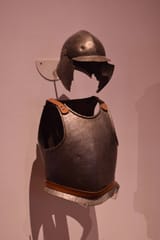Search Results
8/1/2025, 8:42:08 PM
>>64061648
State-issued equipment is, and has always been, made in large identical batches by the lowest bidder. 17th-century gear was so bland that armies needed colored sashes and battle cries-of-the-day just so you could tell friend from foe in a melee. The reason uniforms got brighter and more distinctive as time went on was because dyed cloth got cheaper and the ratio of pikes to muskets slowly decreased from around 5:1 to zero-infinity and battlefield visibility suffered as a result, meaning a general needed help telling which of his units were which.
Do you know why most infantry in the 18th-century wore white pants when the roads were unpaved mud? It was less expensive to issue every soldier with a bag of chalk dust than it was to dye wool and as long as the jackets were distinctive you could cheap out on the other 2/3rds of the uniform. If you were Austria, and realized everyone else had dyed coats, you could cheap out on that too and only dye the facings. If the C^2 of the era hadn't been based on blurry spyglasses (or asking a subaltern what they could see with their non-middle aged eyes) every army would have made the entire uniform out of bleached wool and battles would have been fought between two masses of off-white.
And do you know why most armies to this day have blue uniforms? In the 17th- and 18th-centuries blue was usually the cheapest dark dye available, which meant it was such a common color for uniforms that it still has martial associations centuries later. Buttons were shiny because brass was cheap and easy to cast. Leather was used because it was strong and durable, and it was kept buffed because it lasted longer that way.
Any A-E-S-T-H-E-T-I-C to be found was incidental.
State-issued equipment is, and has always been, made in large identical batches by the lowest bidder. 17th-century gear was so bland that armies needed colored sashes and battle cries-of-the-day just so you could tell friend from foe in a melee. The reason uniforms got brighter and more distinctive as time went on was because dyed cloth got cheaper and the ratio of pikes to muskets slowly decreased from around 5:1 to zero-infinity and battlefield visibility suffered as a result, meaning a general needed help telling which of his units were which.
Do you know why most infantry in the 18th-century wore white pants when the roads were unpaved mud? It was less expensive to issue every soldier with a bag of chalk dust than it was to dye wool and as long as the jackets were distinctive you could cheap out on the other 2/3rds of the uniform. If you were Austria, and realized everyone else had dyed coats, you could cheap out on that too and only dye the facings. If the C^2 of the era hadn't been based on blurry spyglasses (or asking a subaltern what they could see with their non-middle aged eyes) every army would have made the entire uniform out of bleached wool and battles would have been fought between two masses of off-white.
And do you know why most armies to this day have blue uniforms? In the 17th- and 18th-centuries blue was usually the cheapest dark dye available, which meant it was such a common color for uniforms that it still has martial associations centuries later. Buttons were shiny because brass was cheap and easy to cast. Leather was used because it was strong and durable, and it was kept buffed because it lasted longer that way.
Any A-E-S-T-H-E-T-I-C to be found was incidental.
Page 1
